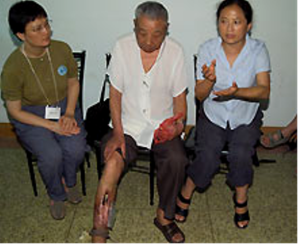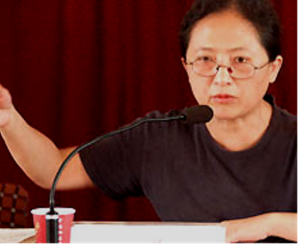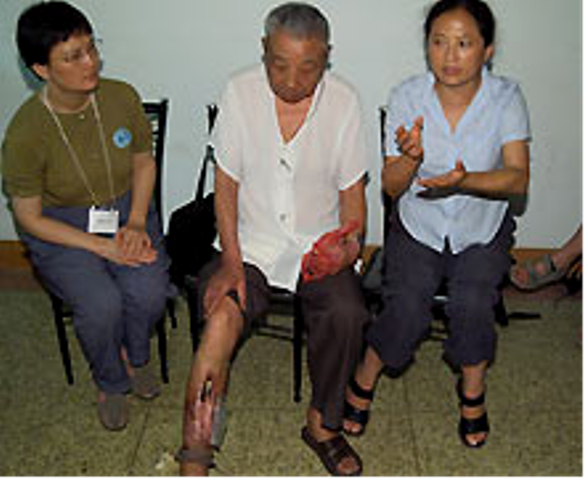From the archives: My CBC Viewpoint China Column from 2005
By Sylvia Yu
For 63 years, Mr. Chen Chong Wen has had to change the bandages on his leg daily. His home-style remedy for his oozing wound is to use a playing card to stop the flow. “There’s no medicine for this,” he said, “it hurts very much and it itches.”
The stench of rotting flesh is overwhelming as he shows his leg. His open sore is terrible-looking and has a tofu-like texture. He feels he’s been a burden to his family because they have to take care of him. “It’s my bad luck,” he says and looks down at the ground.

Chen was infected with “rotten leg disease,” it’s also known as glanders, as he was running away from the Japanese Imperial Army in Zhejiang province in 1942. His mother was also infected. And not too long after her heel rotted off, she died in terrible pain.
At the time he didn’t know why he had met such misfortune, but Chen now knows that he was a victim of biological warfare, inflicted by the Japanese military during an invasion of China.
Chen has had several costly surgeries in the last eight years with no government support. He’s interested in joining a lawsuit against the government of Japan to receive some compensation to ease some of his suffering. So far no single rotten-leg case has been filed against the Japanese government.
Since June 1995, Chinese victims of Japanese war crimes have begun to sue the Japanese government, according to Kang Jian, a Beijing-based human rights lawyer. She says there are 24 cases altogether on behalf of biological warfare survivors, Rape of Nanking (Nanjing) and sexual slavery victims.
“We’re asking relatives to testify and we have survivors to bear witness on the use of biological warfare dropped on villages, and chemical bombs and canisters that are still being unearthed in China,” she says.

Last fall I met another survivor of biological warfare in southern China. I went to visit 77-year-old Ms. Li Meitou in her home village near Tang Xi township.
The tiny woman limps along ahead of me as we walk to her home. She smiles gently and often in spite of the chronic pain she endures. Li has had rotten leg disease since she was 12 years old.
“I’ve had difficulty walking and I experience pain, a fierce burning feeling,” she says. Because she can’t afford medical treatment, she uses some over-the-counter medicine and salt.
Li’s home was a small, dark one-room place with a dirt floor and dingy walls; one small table and bench lined the back. I felt sick that she had to live this way. Why wasn’t she receiving any substantial financial support?
As she sits down she takes off her bandage and shows me her rotting leg. One of my friends has to walk back and turn away because the smell of her open wound made him nauseous. She asked us to tell her story to the world so that all would know what the Japanese did to her and others in her village.
Exact figures of deaths as a result of Japanese biological warfare are hard to come by. But China’s most famous champion of biological warfare survivors, Wang Xuan, who has gathered evidence for lawsuits launched in Tokyo, says as many as 50,000 people in Quzhou died in 1940 from the plague that spread to neighbouring areas until 1948. In total 300,000 people fell ill from this plague attack.

Wang, whose home village in Yiwu was devastated by biological warfare, says the Japanese military used germ-carrying fleas mixed with grains, fibres, beans and cottons. They dropped these “balls” from the sky and let them float down. The local rats then ate the grains, and the fleas also jumped onto small animals and infected people.
The fleas were specially raised to carry germs at the infamous Unit 731 laboratory in Northern China that the Japanese military set up to create and test biological warfare experiments. One Unit 731 veteran testified in a Japanese court how rats and fleas were raised and how 600 kg of anthrax was produced monthly at the compound.
About a decade ago, farmers from Wang’s home village “wanted to fight for their rights and dignity” for the immense suffering and deaths caused by the Japanese military. They sent a petition to the Japanese Embassy in Beijing.
Somehow a group of Japanese peace activists heard about the village and decided to find out more. The Japanese activists reported their findings at an international symposium in Harbin, China, which the Japan Times covered. Wang, who was living in Japan at the time, read the article. The rest is history. She got in touch with people from her village again and eventually became a vocal activist as well as researcher and translator for the Japanese legal team.
The illiterate villagers set up a Japanese biological warfare investigation committee. They were able to obtain a diary of a Japanese military doctor who was stationed with the occupation army in Yiwu. He was a Christian and humane, says Wang. He condemned the war crimes and documented biological warfare activities in his diary.
There was three years of preparation involving the Japanese peace activists, scholars, villagers and local Chinese government. They had an annual medical check up to trace evidences of the plague in the area. Every year, researchers caught 100 rats to see if they still carried the plague, by determining if plague germ antibodies were in their blood.
Up until 1996, plague germs were found in rats. In 2001, a Chinese doctor testified that biological warfare still threatens the Chinese people. His testimony was covered by international news agencies.
The villagers lost their first-ever lawsuit in August 2002. However, the Tokyo District Court confirmed the use of biological warfare by the Japanese Imperial Army. “For the first time in history an office of authority in Japan admitted biological warfare in China. The verdict is in history. The [Japanese court] said biological warfare was in violation of the Geneva Treaty and international agreements and that Japan was responsible for that,” says Wang. “But they said the issue of responsibility was resolved because China gave up her rights [to seek war reparations] in the 1972 Sino-Japan Joint Communiqué.”
In the recent war of words and diplomatic tensions between China and Japan, the most important voices have not been heard. Many actual victims of Japanese war crimes are living in squalid conditions and cannot afford basic medical treatment.
How is it that survivors of cruel, inhumane acts in war, like Chen Chong Wen, have been forgotten? I just don’t understand and shake my head at the Japanese prime minister and his repeat visits to a shrine that honours infamous war criminals (no one responsible for biological warfare was ever convicted for crimes against humanity).
Indeed, I’m dumbfounded at the lack of financial aid for these biological war crime survivors, when I’ve been told China is angry about Japanese history textbooks that whitewash the suffering of the Chinese during the Japanese invasion. The elderly survivors need medical help, and they need financial aid.
I will never forget the sight of Chen Chong Wen weeping. With a pained expression on his face, Chen sobbed loudly, “I don’t want anything else. I just want the wound to close. That’s the only thing I want.”

Hi,
My grandmother was borned in Harbin, she is 85 years old and she have been suffering with this rotten leg disease for decades. She immigrated to Brazil as a refugee and she´ve tried all kinds of treatment and the doctors there couldn´t find the causes of the disease. I just watched a documentary about Unit 731, which led me to read this article and discover the probable cause of my grandma´s leg disease. Untill now, nobody in the family had any idea that there are more people with the same disease, and we can name it as a rotten leg disease. Everybody thought it was related to varicose veins…but I can´t wait to tell her about this!
Hi,
My grandmother was born in Harbin, she is 85 years old and she have been suffering with this rotten leg disease for decades. She immigrated to Brazil as a refugee and she´ve tried all kinds of treatment and the doctors there couldn´t find the causes of the disease. I just watched a documentary about Unit 731, which led me to read this article and discover the probable cause of my grandma´s leg disease. Untill now, nobody in the family had any idea that there are more people with the same disease, and that it has a name. Everybody thought it was related to varicose veins…but I can´t wait to tell her about this!
Hi, thank you for your message. I am interested to know more about your grandmother. Please share what you find. I have asked a few doctors about this disease years ago. Can you send me your email address? Many thanks!
I have your email address now. Thanks much
Hi, I will be glad to share more about her and her story. Now you have my email, we can exchange information there! Happy New Year